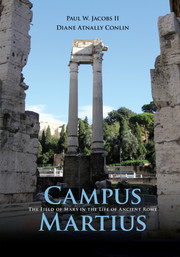Book contents
- Frontmatter
- Contents
- Illustrations
- Acknowledgments
- Maps
- Introduction: “This Place Was Holiest of All”
- Chapter One “The Size of the Plain Is Remarkable”: Defining the Limits of the Campus Martius in Time and Space
- Chapter Two Gathering Troops in the War God's Field
- Chapter Three “Very Costly Temples”: The Campus Martius and Republican Temple Construction
- Chapter Four “Chariot Races,” “Three Theatres,” “An Amphitheatre,” and More: Entertainment in the Campus Martius
- Chapter Five “Colonnades about It in Very Great Numbers”: The Porticoes of the Campus Martius
- Chapter Six Between the Aqua Virgo and the Tiber: Water and the Field of Mars
- Chapter Seven “A Zeal for Buildings”: Reshaping of the Space by the Emperors
- Conclusion: “The Rest of the City a Mere Accessory”
- Appendix A Chronology of Development in the Campus Martius to the Early Fourth Century c.e.
- Appendix B Glossary of Architectural Terms
- Notes
- Selected Bibliography
- Index
- Plate Section
Chapter Four - “Chariot Races,” “Three Theatres,” “An Amphitheatre,” and More: Entertainment in the Campus Martius
Published online by Cambridge University Press: 18 December 2014
- Frontmatter
- Contents
- Illustrations
- Acknowledgments
- Maps
- Introduction: “This Place Was Holiest of All”
- Chapter One “The Size of the Plain Is Remarkable”: Defining the Limits of the Campus Martius in Time and Space
- Chapter Two Gathering Troops in the War God's Field
- Chapter Three “Very Costly Temples”: The Campus Martius and Republican Temple Construction
- Chapter Four “Chariot Races,” “Three Theatres,” “An Amphitheatre,” and More: Entertainment in the Campus Martius
- Chapter Five “Colonnades about It in Very Great Numbers”: The Porticoes of the Campus Martius
- Chapter Six Between the Aqua Virgo and the Tiber: Water and the Field of Mars
- Chapter Seven “A Zeal for Buildings”: Reshaping of the Space by the Emperors
- Conclusion: “The Rest of the City a Mere Accessory”
- Appendix A Chronology of Development in the Campus Martius to the Early Fourth Century c.e.
- Appendix B Glossary of Architectural Terms
- Notes
- Selected Bibliography
- Index
- Plate Section
Summary
Having climbed the slope of the steps of a wooden amphitheater, Corydon, a creation of the poet Titus Calpurnius Siculus, vividly describes taking his seat in the upper level among the poor in their unbleached cloaks and near the benches where women were allowed to view the spectacle below. If the events set out in his eclogue took place in 57 c.e., as many scholars believe, then the poet Calpurnius had likely observed the Campus Martius from the recently completed structure built in less than a year under the orders of Emperor Nero. Employing a veritable forest of wood, including the largest larch tree ever brought to the capital, Calpurnius/Corydon tells us that the amphitheater rose on interwoven beams above the flat plain of the Campus Martius in two curved sections, creating an oval arena on the center floor.
From Corydon's words, we might imagine Calpurnius at the amphitheater surveying the crowd and incidents to include in his work. Before the show grabbed his attention, perhaps he looked out across the Field of Mars and saw in the distance the Capitoline Hill, appearing not much taller than the amphitheater itself. From his high perch atop the theater, the poet would also have seen a remarkable sight. Once a marshy military exercise ground, the plain was now the premier entertainment district within a bustling, urban landscape. Captured in Calpurnius's view from this impressive, albeit temporary entertainment site, would have been the even more extraordinary and permanent stone theaters and amphitheater constructed by great men during the waning days of the republic. These massive edifices significantly influenced the transformation of the topography of the Campus Martius. The Amphitheater of Statilius Taurus was then approaching its ninth decade of hosting gladiatorial and animal exhibitions. Constructed a century before Nero's temporary structure was raised, the curved walls of Rome's first and largest stone theater, the Theater of Pompey, would also have been visible. Indeed, it rose higher than the amphitheater where Calpurnius sat. About half a kilometer southeast of Pompey's theater, another theater sat close to the riverbank, this one built by Augustus to honor his deceased nephew Marcellus.
- Type
- Chapter
- Information
- Campus MartiusThe Field of Mars in the Life of Ancient Rome, pp. 64 - 94Publisher: Cambridge University PressPrint publication year: 2015

